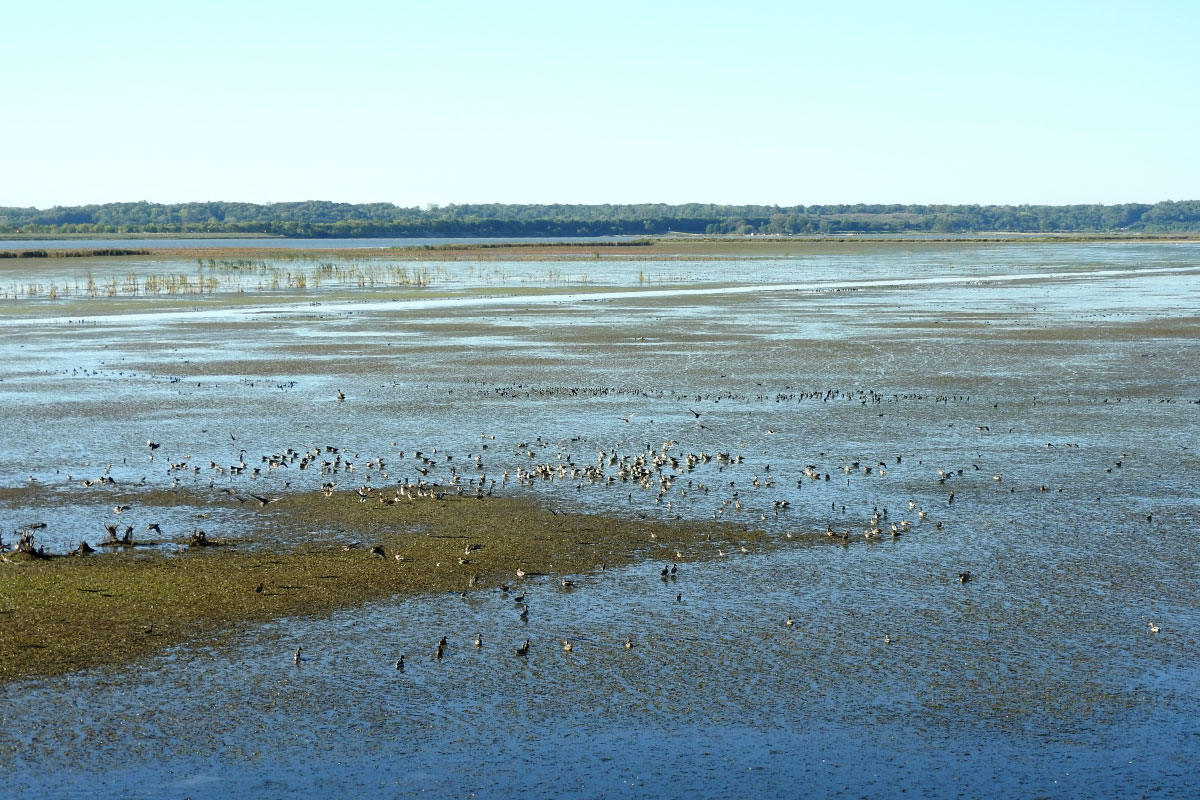
The Nature Conservancy’s Emiquon Preserve is part of the 13,000-acre undertaking. Photo by Ducks Unlimited, Inc.



The Nature Conservancy’s Emiquon Preserve is part of the 13,000-acre undertaking. Photo by Ducks Unlimited, Inc.
Protecting this vital region and keeping that water clean for future generations of ducks and people requires a heavy investment. Ducks Unlimited has invested millions of dollars to conserve more than 7,000 acres of backwater lakes and wetlands along the river. Joining forces with numerous organizations, DU is finding new ways to preserve habitat and ensure the region’s waterfowling heritage continues.
A Major Charge
Ducks Unlimited is leading a $5 million conservation effort to safeguard the valley from further human development and climate change.
The Conserving the Illinois River Legacy initiative combines support from more than a half-dozen partners and federal funding to protect, enhance or restore 13,000 acres across 19 counties bordering the middle and lower stretches of the river. The area is comprised of large backwater lakes, expansive marshes and bottomland hardwood forests.
“It’s a major corridor for birds funneling between northern breeding grounds and southern wintering grounds,” said Michael Sertle, Ducks Unlimited regional biologist. “The Illinois River Valley provides critical habitat for waterfowl and other migratory birds for the food and rest they need to safely continue their journeys.”
The region’s wetlands are popular with outdoors enthusiasts, alleviate downstream flooding and help remove pollutants from rainwater runoff.
But the region has been heavily influenced by human activities.
“During the late 1800s and early 1900s, the area was leveed, ditched, drained, timbered, cleared, burned, farmed and grazed,” Sertle said.
About 90 percent of Illinois’ historic wetlands have been lost and 44 percent of the Illinois River’s 426,000-acre floodplain has been drained for agriculture. Climate change, which causes fluctuating rainfall and changes in flooding and native vegetation, adds another threat.

The Conserving the Illinois River Legacy initiative will protect 1,522 acres of wetlands, restore water to nearly 19 acres of drained wetlands, and enhance 11,461 acres of existing degraded wetlands. The project sites will be open to a variety of different public recreational uses.
The project is funded through a $1 million North American Wetlands Conservation Act (NAWCA) grant with $4.1 million in matching and non-matching support from Ducks Unlimited, Wetlands America Trust, The Nature Conservancy, The Wetlands Initiative, Illinois Department of Natural Resources (IDNR), Peoria Park District, Friends of Sanganois, Illinois River Valley Conservation Group, and the U.S. Fish and Wildlife Service Partner’s for Fish and Wildlife Program, with support from the Illinois Natural History Survey’s Forbes Biological Station.
The initiative has 11 project sites including:
“Working in concert with partners such as Ducks Unlimited and The Wetlands Initiative allows us to maximize the return on our investment in nature. Our combined efforts, which involve a host of partners, volunteers and donors, have yielded incredible restoration and protection results in this region while providing an enhanced experience for both people and nature,” said Michelle Carr, The Nature Conservancy Illinois state director. “We eagerly anticipate the infrastructure upgrades that will protect the Conservancy’s 5,500-acre wetland at Emiquon as well as our neighboring landowners.”
Randy Smith, Wetland Wildlife Program manager for the Illinois Department of Natural Resources, said the NAWCA funding highlights the strong partnership between Ducks Unlimited and the Illinois DNR.
“We are excited about the potential this funding will bring, and the ability to enhance some of our traditionally great wetland management areas, increasing habitat quality for waterfowl, other wetland dependent wildlife, waterfowl hunters and other users of our State Fish and Wildlife Areas,” he said.
This new program is part of DU’s overall Big Rivers Initiative, which focuses on conserving the Mississippi River and its major tributaries.
Touring The History
The Illinois River is rich in waterfowling tradition. It has a history of extensive market hunting in the early 1900s to provide food to large cities, has some of the oldest waterfowl hunting clubs in the United States, is home to notable decoy carvers and waterfowl call makers and was the spot for some of the earliest waterfowl research.
A new vehicular interpretive trail invites motorists to trace the rich heritage of waterfowling and conservation rooted in the Illinois River Valley.
Ducks Unlimited and the Miles C. Hauter Foundation have established the Miles C. Hauter Trail, a series of informational panels at 10 historical waypoints throughout the Illinois River Road National Scenic Byway. The route winds along Illinois Routes 29 and 26, from Hennepin south to Peoria. Along the way, trail visitors can learn about the area’s duck hunting history and explore the conservation work done by Ducks Unlimited and its partners to conserve Illinois River wetlands.
An interactive tour showing waypoint locations is available here.
Mike Sertle is the Ducks Unlimited Regional Biologist for Illinois.

Ducks Unlimited Inc. is the world’s largest nonprofit organization dedicated to conserving North America’s continually disappearing waterfowl habitats. Established in 1937, Ducks Unlimited has conserved more than 14.5 million acres thanks to contributions from more than a million supporters across the continent. Guided by science and dedicated to program efficiency, DU works toward the vision of wetlands sufficient to fill the skies with waterfowl today, tomorrow and forever. For more information on our work, visit www.ducks.org.
Submit a question for the author